The Animal External Fixation Market is estimated to be valued at USD 1.4 billion in 2025 and is projected to reach USD 3.1 billion by 2035, registering a compound annual growth rate (CAGR) of 8.1% over the forecast period.
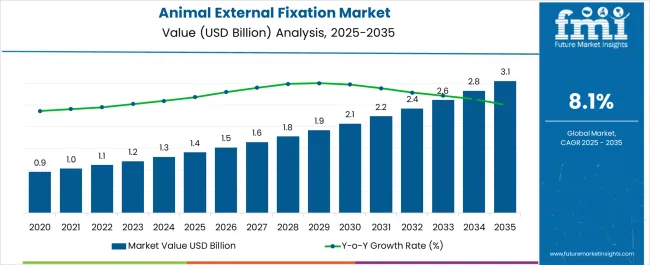
| Metric | Value |
|---|---|
| Animal External Fixation Market Estimated Value in (2025 E) | USD 1.4 billion |
| Animal External Fixation Market Forecast Value in (2035 F) | USD 3.1 billion |
| Forecast CAGR (2025 to 2035) | 8.1% |
The Animal External Fixation market is witnessing consistent growth, driven by increasing adoption of advanced orthopedic treatment solutions in veterinary care. Rising incidences of fractures, trauma, and orthopedic disorders in companion and farm animals are creating a demand for effective fixation devices that ensure proper healing and mobility. The market is further supported by advancements in external fixation technologies that provide stability, adjustability, and minimally invasive application for diverse animal species.
Growing awareness among veterinarians regarding post-surgical recovery, reduced complication rates, and enhanced animal welfare is accelerating adoption. Veterinary hospitals and clinics are increasingly integrating external fixation systems into standard treatment protocols to improve patient outcomes. The expansion of the veterinary healthcare infrastructure, combined with training programs for specialized orthopedic procedures, is further contributing to market growth.
Additionally, the demand for scalable, reusable, and customizable devices that can cater to various animal sizes and species continues to support market adoption As veterinary care standards rise globally, the Animal External Fixation market is expected to maintain steady growth over the forecast period.
The animal external fixation market is segmented by fixation type, product type, and geographic regions. By fixation type, animal external fixation market is divided into Ehmer Sling, Velpeau Sling, and Others. In terms of product type, animal external fixation market is classified into Veterinary Hospitals and Veterinary Clinics. Regionally, the animal external fixation industry is classified into North America, Latin America, Western Europe, Eastern Europe, Balkan & Baltic Countries, Russia & Belarus, Central Asia, East Asia, South Asia & Pacific, and the Middle East & Africa.
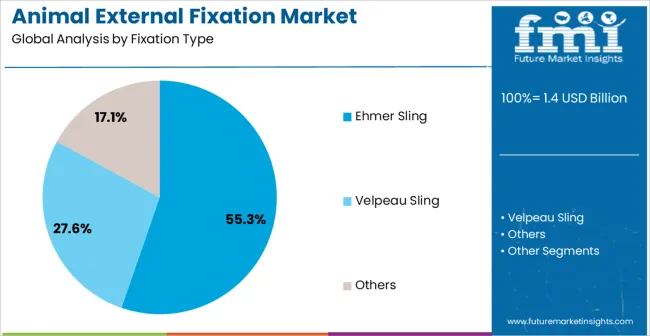
The Ehmer sling segment is projected to hold 55.3% of the market revenue in 2025, establishing it as the leading fixation type. Growth in this segment is being driven by its efficacy in immobilizing pelvic and hind limb fractures in animals, particularly small and medium-sized companions. The Ehmer sling provides adjustable support that facilitates proper alignment during the healing process while minimizing discomfort and reducing the risk of secondary injuries.
Its non-invasive application and compatibility with other orthopedic treatments enhance its clinical utility. Veterinary surgeons favor the Ehmer sling for its reliability in managing post-operative recovery, especially for complex fractures that require continuous stabilization. Increased awareness of animal welfare and improved surgical outcomes has further strengthened its adoption in veterinary hospitals.
Continuous training programs, research on orthopedic recovery, and the availability of high-quality materials are reinforcing the preference for Ehmer slings As demand for effective fracture management solutions grows, the Ehmer sling segment is expected to maintain market leadership due to its proven clinical benefits and adaptability across animal species.
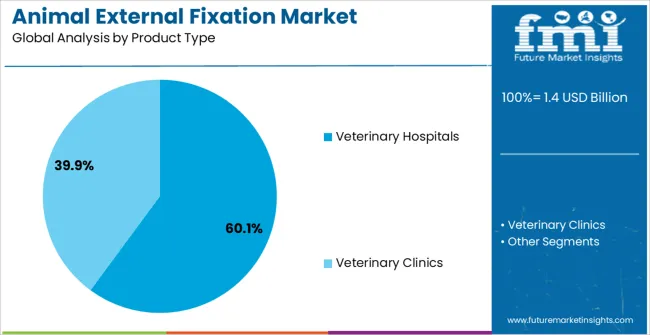
The veterinary hospitals product type segment is anticipated to account for 60.1% of the market revenue in 2025, making it the leading end-use category. Growth in this segment is being driven by the increasing number of specialized veterinary facilities providing advanced orthopedic care and post-operative rehabilitation. External fixation devices, including Ehmer slings and modular fixation systems, are widely deployed in hospitals to treat fractures, joint disorders, and complex trauma cases.
The availability of trained orthopedic veterinarians and adoption of standardized treatment protocols enhances the effectiveness and reliability of these devices. Integration of external fixation solutions into routine clinical practice supports better patient outcomes, faster recovery, and reduced complication rates.
Hospitals are investing in high-quality, reusable, and customizable fixation equipment to ensure optimal care for diverse animal species, including small pets, large animals, and livestock With rising awareness of veterinary care standards, regulatory emphasis on animal welfare, and growing demand for advanced treatment options, the veterinary hospitals segment is expected to continue dominating the market, driven by consistent adoption of clinically effective external fixation solutions.
Animal external fixation is a versatile treatment for fracture repair and used in the enhancement of both biological and mechanical environment for optimal healing of the fracture. Animal External Fixation used to serve as a secondary support or temporary support after surgical intervention and to keep limb in a neutral position.
It mainly used in the prevention of compression, rotation, bending and distraction of the fractured bone. External fixation mainly involves inserting pins in the proximal and distal locations of the fractures to provide mechanical strength to the bone in cases like comminuted bones, infected fractures, delayed wound healing and osteotomies. Basically, these pins were connected by clamps to bar.
Based on a number of planes and surface penetrated, they are classified into following types namely: Unilateral-Uniplanar, Unilateral-Biplanar, Bilateral-Uniplanar, Bilateral-Biplanar and etc.
On the basis of fixation type, they were classified into Ehmer sling used in providing stability of cranial and dorsal hip dislocation, Velpeau sling used to keep shoulder joint, elbow, and carpus in position, and Schroeder-Thomas splints are used in fracture distal to mid-humerus or mid-femur. Other types are metal spoon splints, B. SPLICA Splints, and C. Spoon Splints. Casts are mainly used to provide immobilization after surgery.
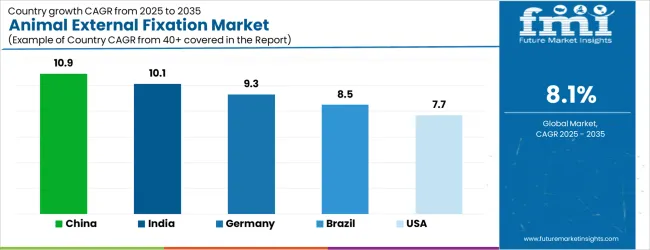
| Country | CAGR |
|---|---|
| China | 10.9% |
| India | 10.1% |
| Germany | 9.3% |
| Brazil | 8.5% |
| USA | 7.7% |
| UK | 6.9% |
| Japan | 6.1% |
The Animal External Fixation Market is expected to register a CAGR of 8.1% during the forecast period, exhibiting varied country level momentum. China leads with the highest CAGR of 10.9%, followed by India at 10.1%. Developed markets such as Germany, France, and the UK continue to expand steadily, while the USA is likely to grow at consistent rates. Japan posts the lowest CAGR at 6.1%, yet still underscores a broadly positive trajectory for the global Animal External Fixation Market. In 2024, Germany held a dominant revenue in the Western Europe market and is expected to grow with a CAGR of 9.3%. The USA Animal External Fixation Market is estimated to be valued at USD 529.1 million in 2025 and is anticipated to reach a valuation of USD 529.1 million by 2035. Sales are projected to rise at a CAGR of 0.0% over the forecast period between 2025 and 2035. While Japan and South Korea markets are estimated to be valued at USD 71.3 million and USD 39.7 million respectively in 2025.
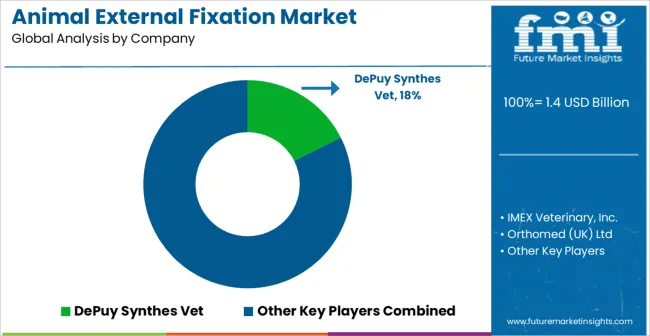
| Item | Value |
|---|---|
| Quantitative Units | USD 1.4 Billion |
| Fixation Type | Ehmer Sling, Velpeau Sling, and Others |
| Product Type | Veterinary Hospitals and Veterinary Clinics |
| Regions Covered | North America, Europe, Asia-Pacific, Latin America, Middle East & Africa |
| Country Covered | United States, Canada, Germany, France, United Kingdom, China, Japan, India, Brazil, South Africa |
| Key Companies Profiled | DePuy Synthes Vet, IMEX Veterinary, Inc., Orthomed (UK) Ltd, Veterinary Orthopedic Implants, Inc., Securos Surgical, BioMedtrix, LLC, Kyon AG, Integra LifeSciences Corporation, SurgiVet, Inc., B. Braun Vet Care GmbH, Everost, Inc., Fusion Implants, Jorgensen Laboratories, and VetImaging |
The global animal external fixation market is estimated to be valued at USD 1.4 billion in 2025.
The market size for the animal external fixation market is projected to reach USD 3.1 billion by 2035.
The animal external fixation market is expected to grow at a 8.1% CAGR between 2025 and 2035.
The key product types in animal external fixation market are ehmer sling, velpeau sling and others.
In terms of product type, veterinary hospitals segment to command 60.1% share in the animal external fixation market in 2025.






Our Research Products

The "Full Research Suite" delivers actionable market intel, deep dives on markets or technologies, so clients act faster, cut risk, and unlock growth.

The Leaderboard benchmarks and ranks top vendors, classifying them as Established Leaders, Leading Challengers, or Disruptors & Challengers.

Locates where complements amplify value and substitutes erode it, forecasting net impact by horizon

We deliver granular, decision-grade intel: market sizing, 5-year forecasts, pricing, adoption, usage, revenue, and operational KPIs—plus competitor tracking, regulation, and value chains—across 60 countries broadly.

Spot the shifts before they hit your P&L. We track inflection points, adoption curves, pricing moves, and ecosystem plays to show where demand is heading, why it is changing, and what to do next across high-growth markets and disruptive tech

Real-time reads of user behavior. We track shifting priorities, perceptions of today’s and next-gen services, and provider experience, then pace how fast tech moves from trial to adoption, blending buyer, consumer, and channel inputs with social signals (#WhySwitch, #UX).

Partner with our analyst team to build a custom report designed around your business priorities. From analysing market trends to assessing competitors or crafting bespoke datasets, we tailor insights to your needs.
Supplier Intelligence
Discovery & Profiling
Capacity & Footprint
Performance & Risk
Compliance & Governance
Commercial Readiness
Who Supplies Whom
Scorecards & Shortlists
Playbooks & Docs
Category Intelligence
Definition & Scope
Demand & Use Cases
Cost Drivers
Market Structure
Supply Chain Map
Trade & Policy
Operating Norms
Deliverables
Buyer Intelligence
Account Basics
Spend & Scope
Procurement Model
Vendor Requirements
Terms & Policies
Entry Strategy
Pain Points & Triggers
Outputs
Pricing Analysis
Benchmarks
Trends
Should-Cost
Indexation
Landed Cost
Commercial Terms
Deliverables
Brand Analysis
Positioning & Value Prop
Share & Presence
Customer Evidence
Go-to-Market
Digital & Reputation
Compliance & Trust
KPIs & Gaps
Outputs
Full Research Suite comprises of:
Market outlook & trends analysis
Interviews & case studies
Strategic recommendations
Vendor profiles & capabilities analysis
5-year forecasts
8 regions and 60+ country-level data splits
Market segment data splits
12 months of continuous data updates
DELIVERED AS:
PDF EXCEL ONLINE
Animal Healthcare Packaging Market Size and Share Forecast Outlook 2025 to 2035
Animal Antibiotics and Antimicrobials Market Size and Share Forecast Outlook 2025 to 2035
Animal Auto-Immune Disease Diagnostics Market Size and Share Forecast Outlook 2025 to 2035
Animal Disinfectants Market Size and Share Forecast Outlook 2025 to 2035
Animal Health Software Market Size and Share Forecast Outlook 2025 to 2035
Animal Antimicrobials and Antibiotics Market Size and Share Forecast Outlook 2025 to 2035
Animal Sedative Market Size and Share Forecast Outlook 2025 to 2035
Animal Genetics Market Size and Share Forecast Outlook 2025 to 2035
Animal Peptides Market Size and Share Forecast Outlook 2025 to 2035
Animal Immunoassay Kits Market Analysis - Size, Share, and Forecast Outlook 2025 to 2035
Animal Gastroesophageal Reflux Disease Market Size and Share Forecast Outlook 2025 to 2035
Animal Parasiticide Market Size and Share Forecast Outlook 2025 to 2035
Animal Model Market Analysis - Size, Share, and Forecast Outlook 2025 to 2035
Animal Feed Additives Market Analysis - Size, Share, & Forecast Outlook 2025 to 2035
Animal Feed Organic Trace Minerals Market Size and Share Forecast Outlook 2025 to 2035
Animal Nutrition Chemicals Market Analysis - Size, Share, and Forecast Outlook 2025 to 2035
Animal Artificial Insemination Market Report - Trends, Demand & Industry Forecast 2025 to 2035
Animal Wound Care Market Size and Share Forecast Outlook 2025 to 2035
Animal Parasiticides Market Size and Share Forecast Outlook 2025 to 2035
Animal Feeds Microalgae Market Size and Share Forecast Outlook 2025 to 2035

Thank you!
You will receive an email from our Business Development Manager. Please be sure to check your SPAM/JUNK folder too.
Chat With
MaRIA